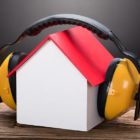If you are considering installing sound insulation in a new building, something you will need to consider is structure-borne sound. This may well be a term you have heard of, although you may not know what it means.
According to Part E of UK Building Regulations in the UK, structure borne sound is that which is passed or transmitted via solid structures. This includes sounds like dropping items on the floor, slamming doors and even footsteps.
Key to this type of sound, which is tested for during the course of any sound testing carried out as per Part E of Building Regulations is, as the property owner or resident, understanding what are the steps that can be taken to lessen the effects. Also important to understand is the difference between structure and airborne sound, both of which are tested for.
What Is Structure Borne Sound?
In any building or property, sound reaches us in two different ways. Sound can be airborne, which relates to the sound waves pulsating through the air before they reach the ear. When living in a shared property or house of multiple occupancy (HMO), this could for example include the sound of a neighbour shouting or sneezing, or perhaps the television from another room in the property.
The other type of sound transmitted is structure borne sound. Structure borne sound relates to the sound waves pulsating and radiating through a solid structure or medium before they reach the human ear. For example, the noise of footsteps from a room above would-be structure borne sound caused by the impact of the footsteps reverberating through the floorboards.
What Problems Can Structure Borne Sound Cause?
Structure borne sound can be a real issue for homes if they are poorly designed, becoming a particular problem in the same types of properties and property conversions that require sound insulation testing.
Noise complaints are the number one reason for neighbour disputes and unwanted noise can over time have a negative impact on our mental well-being. It is therefore very important to consider the effects of structure borne sound when you are designing or renovating a home, even before undertaking the necessary sound testing. A home should feel like a sanctuary and minimising structure borne sound can help to reduce noise pollution and make your home more peaceful.
Even in a commercial or office space reducing structure borne sound remains important, not only to meet building codes but to make a space functional.
How Can Structure Borne Sound Be Reduced?
There are a few ways to reduce the effects of structure borne sound:
- Create a gap – One of the best ways to reduce structure borne sound is to have a structure, then an air gap and then a solid structure again. This way you can break up the contact between masses and reduce structure borne sound. You can break up contact between masses by installing things like suspended ceilings, raised floors, or secondary wall structures. These are going to reduce the transmission of any sound waves
- Carpets and padding can massively cut down on structure borne sound and absorb sound waves and installing thicker carpet is one of the cheaper ways to reduce structure borne sound
- Resilient underlay – In some cases, the use of underlay can reduce structure borne sound and help soundproof a room. You can find underlays made from rigid fiberglass, foam or recycled rubber
- Install anti-vibration measures – Anti-vibration mounts, sound clips and spring ceiling hangers can all dampen structural borne noises
Although these measures can all reduce the amount of structure borne sound transmitted, totally eliminating such sound can be complex. Appropriate building design features can mitigate the effects of structure borne sound, but it does depend on a number of factors including the structural composition. The composition of the structure through which the sound is vibrating, the radiating surface and the receiving space can all affect the level of structure borne sound.
Specialist acoustic consultants are vital in designing spaces sensitive to sound and many architects and consultant companies will employ the service of a specialist acoustic consultant to help mitigate noise pollution and structure borne sounds. An acoustic consultant will help assess, design, manage and control structural vibrations to help minimise unwanted noise in a space and help architects to meet building standards.



